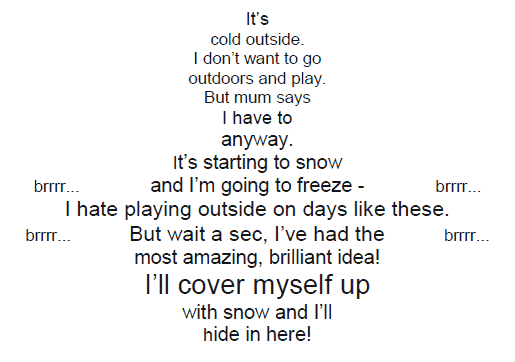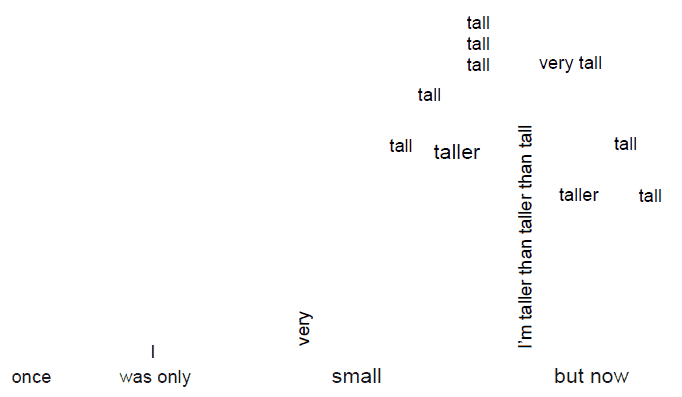What is a Concrete Poem?
Concrete poetry—sometimes also called ‘shape poetry’—is poetry whose visual appearance matches the topic of the poem. The words form shapes which illustrate the poem’s subject as a picture, as well as through their literal meaning.
This type of poetry has been used for thousands of years, since the ancient Greeks began to enhance the meanings of their poetry by arranging their characters in visually pleasing ways back in the 3rd and 2nd Centuries BC.
A famous example is “The Mouse’s Tale” from Lewis Carroll’s Alice’s Adventures in Wonderland. The shape of the poem is a pun on the word tale/tail, as the words follow a long wiggling line getting smaller and smaller and ending in a point.
The name “Concrete Poetry,” however, is from the 1950’s, when a group of Brazilian poets called the Noigandres held an international exhibition of their work, and then developed a “manifesto” to define the style.
The manifesto states that concrete poetry ‘communicates its own structure: structure = content’
There are 2 main ways that this can be achieved…
Outline Poems
A common way to make the visual structure reflect the subject of the poem is to fill an outline shape that relates to the topic of the poem, in the same way that Carroll’s poem fits the outline of a mouse’s tail.
Here is an example about a snowman:

- Choose an object to be the subject for your poem. Good suggestions for beginners could be favorite animals or favorite foods.
- Draw a simple outline of its shape on paper or on the computer. If you’re using paper, draw with a pencil not a pen.
- Write your poem normally. Try to describe how the subject makes you feel. The words will be fitted into your drawing, so don’t make it too long – between 6-12 lines is probably a good length!
IT DOESN’T HAVE TO RHYME!
- Lightly in pencil, or on the computer, write your poem into the shape. It’s ok if it doesn’t fit properly yet, because this is where you find out if you need to make the writing larger or smaller.
- Decide if you need to make your writing bigger or smaller in certain parts of the drawing, then erase your first draft and write out the poem again. You can keep doing this until you are happy.
- Finally, erase the outline of your shape, so that it is just the words from your poem left creating the image! If you were writing in pencil, you can now go over the words in pen!
- (In my example I added the ‘brrr…’s afterwards to make the picture look better, but without interrupting the story of the poem. If you want to try details like this, think of comic-book-style effect words like ‘flash’, ‘purr’, ‘phew’ or ‘zzzz…’ to add another element to the story-picture!)
Drawing Poems
Another way to make concrete poetry is to use the lines of words to make the lines of a drawing. The NASA website has a great example about the first ever airplanes if you click here.
This time, the subject doesn’t have to be an object, but it does have to be something you can draw an illustration of using ‘stick’ figures.
This is my example of ‘growing’:

- Choose your subject
- Draw a simple line – or ‘stick’ – drawing to illustrate your subject on paper or on the computer. If you’re using paper, draw with a pencil not a pen.
- Write your poem normally. Simple is best, so stick to between 2-6 lines.
IT DOESN’T HAVE TO RHYME!
- Lightly in pencil, or on the computer, write the lines of your poem along the lines of your drawing – remember that we normally read from left to right, and from top to bottom!
- If you don’t have enough words, or have some left over, don’t worry! Decide where you need to make your writing bigger or smaller to make it all fit, then erase your first draft and write out the poem again over your line drawing. You can keep doing this until you are happy.
- Finally, erase the line drawing, so that it is just the words from your poem left creating the image! (If you were writing in pencil, go over the writing in pen first.)
(In my example I wanted to add branches to the tree, so used repeated words from my poem to highlight the theme, and make the picture better. If you want to add details like this, think about what the most important word is in your poem and use the one that best sums up its message!)
- Create Your Own Poetic Puppet Show - April 16, 2024
- Leap into Laughter with “A Festival for Frogs” - March 26, 2024
- New Book! A Festival for Frogs - March 5, 2024






